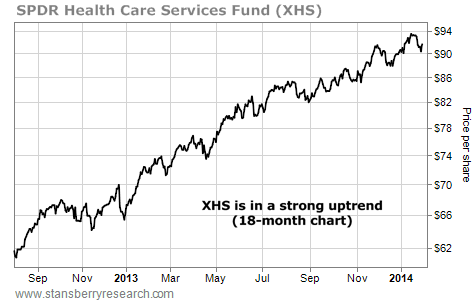| Home | About Us | Resources | Archive | Free Reports | Market Window |
A "Backdoor" Way to Invest in Surging Natural Gas PricesBy
Friday, January 31, 2014
The price of natural gas is skyrocketing...
Two years ago, the price of natural gas was $2.50 per thousand cubic feet (mcf). Now, it's more than 100% higher.
Natural gas is a MAJOR component of our economy. We get 30% of our electricity from power plants that burn natural gas. We use it to heat our homes and factories. We use it to make plastic and agricultural fertilizer.
And now, the price of this vital fuel is soaring. And there's a great "backdoor" way to invest in it. But it doesn't involve buying natural gas companies...
The way to make money from soaring natural gas prices is to own coal stocks.
Let me explain...
As I mentioned, natural gas is a major fuel for electrical power plants. Natural gas was responsible for 30% of U.S. electricity production in 2012. Coal is a "competitor fuel." The U.S. got 37% of its electricity from coal-fired power plants.
In 2007 and 2008, natural gas regularly traded over $8 per mcf. Then, new drilling technologies allowed us to unlock huge amounts of oil and gas in North America. This supply surge sent natural gas prices tumbling to a low of around $2 per mcf in 2012.
The natural gas price collapse pulled the price of coal down with it. Coal prices are down 24% since 2011. And coal stocks have been crushed.
As I mentioned, natural gas is up more than 100% in the past two years. Since bottoming in 2012, prices have climbed 175%. The recent cold weather has sent prices from $3.50 to $5.25 in just the past two months.
I think it's unlikely that natural gas will climb past $6. We have too much supply available. But it's very likely that it will stay north of $4. And that price will act as a "tailwind" for coal prices and coal stocks.
However, the data so far doesn't support that conclusion...
The table below shows the changes from 2012 to 2013 in consumption and price for natural gas and coal.
As natural gas prices rose, customers used less. But coal hasn't come to the rescue... yet. Clearly, coal and natural gas consumption were both down in 2013. And to make matters worse, coal prices fell, too.
The data shows that, at least through November 2013, coal isn't replacing natural gas right now... But the rising price of natural gas should eventually spark more consumption of coal. That's because some power plants can substitute coal for natural gas to generate electric power.
The shares of giant coal producer Peabody Coal (BTU) don't support the idea of a rally, either. Shares rallied from a bottom in June 2013 to a peak in November. Since then, shares are down more than 20%.
That's not a sign that domestic natural gas prices are bullish for coal... yet. But if natural gas prices remain high, it WILL be good for coal eventually. And beaten-down coal stocks like Peabody will enjoy a big rally.
Good investing,
Further Reading:
Matt says there's another factor that will send coal prices higher – India. "Its rising energy needs will make a big impact in the resource markets in the future – including pushing the price of coal higher," he writes. Get all the details here.
"If your portfolio doesn't have any natural resource companies in it yet, don't wait too much longer," Matt writes. "I think this bear market is over..." Find out why here: What You Need to Know to Trade Natural Resources in 2014.
Market NotesJUST ANOTHER NATURAL CORRECTION Today's chart is the definition of an uptrend: higher highs and higher lows.
Nobody likes to see an investment move lower. But it's natural, even in a big bull market, for prices to correct after a move higher. Stocks in an uptrend are like sprinters... They need to "catch their breath" from time to time.
The SPDR Health Care Services Fund (XHS) holds shares of companies that support the health care system. Express Scripts manages prescription plans... DaVita offers dialysis services... HCA operates hospitals. As long as Baby Boomers keep getting older, these companies will continue to profit.
XHS recently saw a 3% correction... And it surely scared some investors out of the fund. But if you're holding an investment with a chart like this one, there's nothing to do but hold on.
 |
In The Daily Crux
Recent Articles
|


